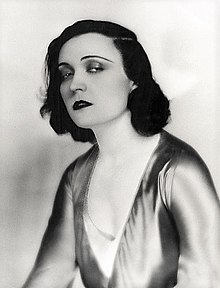
Back Pola Negri Afrikaans Pola Negri AN بولا نيجري Arabic پولا نيجرى ARZ پولا نقری AZB Пола Негры Byelorussian Пола Негри Bulgarian Pola Negri Catalan Pola Negri Czech Pola Negri Danish
Pola Negri | |
|---|---|
 Negri in 1931 | |
| Born | Barbara Apolonia Chałupiec 3 January 1897 |
| Died | 1 August 1987 (aged 90) San Antonio, Texas, U.S. |
| Resting place | Calvary Cemetery (Los Angeles), California, U.S. 34°01′42″N 118°10′36″W / 34.02833°N 118.17667°W |
| Nationality | Polish |
| Occupations |
|
| Years active | 1914–1964 |
| Spouses | |
Pola Negri (/ˈpoʊlə ˈnɛɡri/; born Barbara Apolonia Chałupiec[a] [apɔˈlɔɲa xaˈwupʲɛt͡s];[b] 3 January 1897[c] – 1 August 1987) was a Polish stage and film actress and singer. She achieved worldwide fame during the silent and golden eras of Hollywood and European film for her tragedienne and femme fatale roles. She was also acknowledged as a sex symbol of her time.[12]
Raised in the Congress Kingdom of Poland, Negri's childhood was marked by several personal hardships: After her father was sent to Siberia, she was raised by her single mother in poverty, and suffered tuberculosis as a teenager. Negri recovered, and went on to study ballet and acting in Warsaw, Poland, becoming a well-known stage actress there. In 1917, she relocated to Germany, where she began appearing in silent films for the Berlin-based UFA studio. Her film performances for UFA came to the attention of Hollywood executives at Paramount Pictures, who offered her a film contract.
Negri signed with Paramount in 1922, making her the first European actress in history to be contracted in Hollywood. She spent much of the 1920s working in the United States appearing in numerous films for Paramount, establishing herself as one of the most popular actresses in American silent film. In the 1930s, during the emergence of sound film, Negri returned to Europe, where she appeared in multiple films for Pathé Films and UFA, and also began a career as a recording artist. She made only two films after 1940, her last screen credit being in Walt Disney's The Moon-Spinners (1964).
Negri spent her later life largely outside the public sphere. She became a naturalized U.S. citizen in 1951, and spent the remainder of her life living in San Antonio, Texas. In 1987, aged 90, she died of pneumonia secondary to a brain tumor for which she refused treatment.
- ^ "Pola Negri Biografia". Retrieved 22 December 2023.
- ^ "Pola Negri". Retrieved 22 December 2023.
- ^ "Pola Negri". Retrieved 22 December 2023.
- ^ Ancestry Library Edition[verification needed]
- ^ "Pola Negri's birth certificate from 1978". Retrieved 28 August 2016.
- ^ "Pola Negri's birth certificate from 1960". Retrieved 28 August 2016.
- ^ Kotowski, Mariusz. Pola Negri: Life is a Dream in Cinema, Bright Shining City Productions (2006), DVD
- ^ Martin Votruba (12 April 2013). "Pola Negri". Slovak Studies Program. University of Pittsburgh. Retrieved 22 January 2015.
The exact spelling of her and her parents' names is complicated by the mandated use of Russian in government records in that part of [partitioned] Poland, when she was born. For instance, her father's last name is recorded as Халупец at the Lipno Office of Vital Records, which can be rendered in Polish as Chalupec, Chałupec, Chalupiec, or Chałupiec.
- ^ Long, Christopher. "Chalupec, Barbara Apolonia (Pola Negri)". Texas State Historical Society. Handbook of Texas Online. Retrieved 28 February 2018.
- ^ Kotowski 2014, p. 5.
- ^ Kotowski 2014, p. 6.
- ^ Mariusz Kotowski (2014). Pola Negri: Hollywood's First Femme Fatale. University Press of Kentucky. p. 277. ISBN 9780813144894. Retrieved 20 June 2020.
Cite error: There are <ref group=lower-alpha> tags or {{efn}} templates on this page, but the references will not show without a {{reflist|group=lower-alpha}} template or {{notelist}} template (see the help page).
© MMXXIII Rich X Search. We shall prevail. All rights reserved. Rich X Search